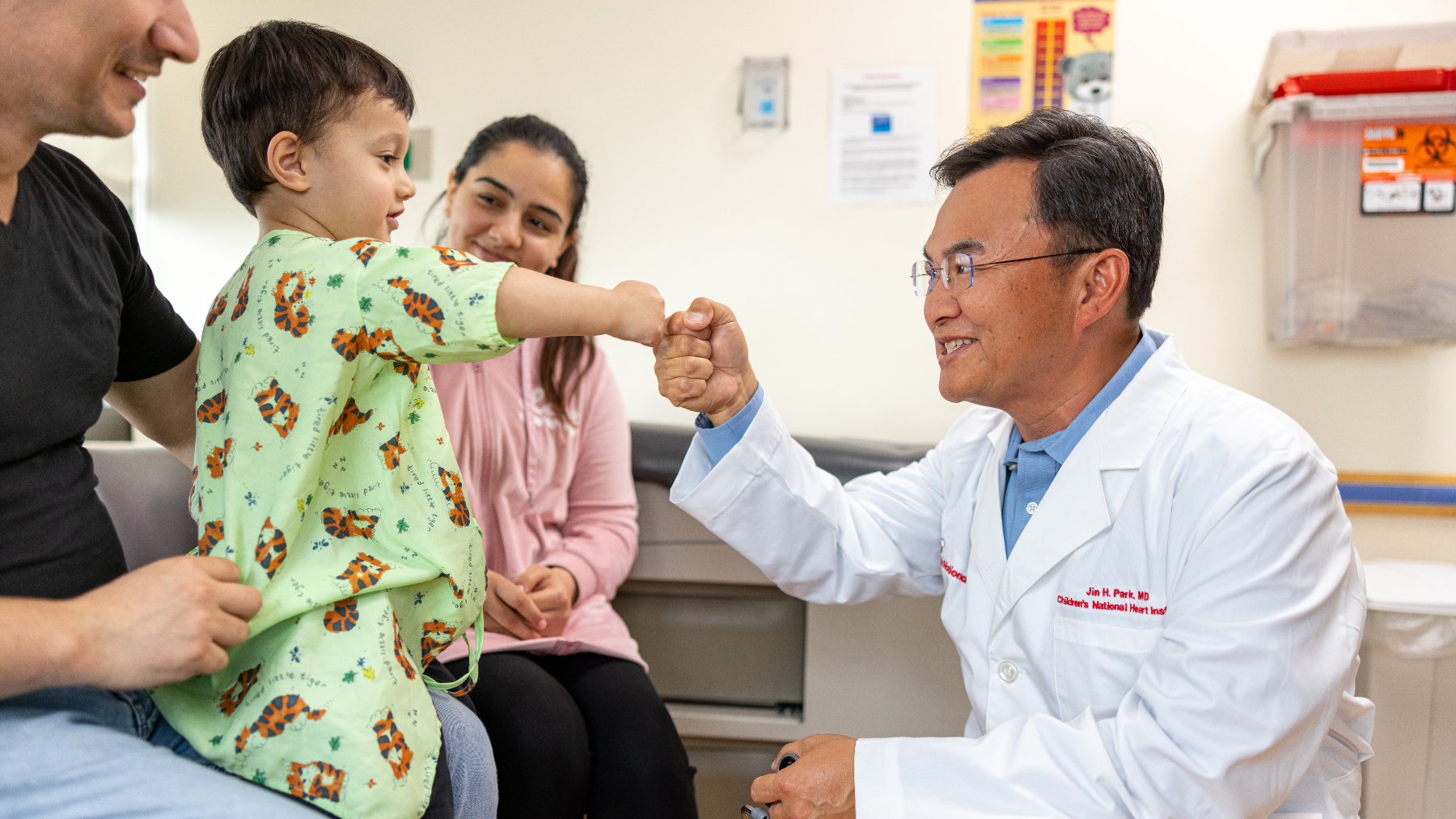Condition
Pediatric Total Anomalous Pulmonary Venous Return (TAPVR)
What You Need to Know
Total anomalous pulmonary venous return (TAPVR) is a congenital (present at birth) heart defect. Due to abnormal development of the prenatal heart during the first eight weeks of pregnancy, the vessels that bring oxygen-rich (red) blood back to the heart from the lungs are improperly connected.
Key Symptoms
The most common symptoms of TAPVR are:
- Blue coloring of the skin, lips and nail beds
- Rapid and/or labored breathing
- Rapid heart rate
- Cool, clammy skin
Diagnosis
Doctors typically diagnose TAPVR by:
- Physical examination
- Chest X-ray
- Electrocardiogram (ECG or EKG)
- Echocardiogram (echo)
- Cardiac catheterization
Treatment
Treatment may include:
- Medical management
- Interventional cardiac catheterization
- Surgery
Schedule an Appointment
Our pediatric specialists provide personalized care for your child’s physical, mental and emotional health needs. Meet our providers and schedule an appointment today.
Frequently Asked Questions
Prevention and Risk Assessment
What causes total anomalous pulmonary venous return in children?
TAPVR occurs the first eight weeks of prenatal development, when the heart is forming.
Normally, oxygen-poor (blue) blood returns to the right atrium from the body, travels to the right ventricle, then is pumped through the pulmonary artery into the lungs where it receives oxygen. Oxygen-rich (red) blood returns to the left atrium from the lungs through four pulmonary veins. It then passes into the left ventricle, and is pumped through the aorta out to the body.
In TAPVR, the four pulmonary veins are connected somewhere besides the left atrium. There are several possible places where the pulmonary veins can connect. The most common connection is to a blood vessel that brings oxygen-poor (blue) blood back to the right atrium, usually the superior vena cava.
In TAPVR, oxygen-rich (red) blood that should return to the left atrium, the left ventricle, the aorta and then the body, instead mixes with the oxygen-poor (blue) blood flowing into the right side of the heart. This situation by itself will not support life, because there is no way for oxygen-rich (red) blood to be delivered to the body.
- Other heart defects are often associated with TAPVR and they actually help the infant with total anomalous pulmonary venous return to live until surgical intervention is possible:
- An opening in the atrial septum will allow blood from one side to mix with blood from another, creating "purple" blood with an oxygen level somewhere in-between that of the oxygen-poor (blue) and the oxygen-rich (red) blood.
Total anomalous pulmonary venous return occurs equally in boys and in girls.
Why is TAPVR a concern for children?
Babies with this heart defect cannot supply oxygen-rich (red) blood to the body after birth. Without an additional heart defect that allows mixing of oxygen-poor (blue) and oxygen-rich (red) blood, such as an atrial septal defect, infants with TAPVR will have a mixture of oxygen-rich (red) and oxygen-poor (blue) blood circulating through the right heart and back to the lungs — a situation that is fatal.
Two fetal "shunts," or connections present in the fetal circulation, remain open for a short while after birth.
- The foramen ovale, an opening between the right atrium and the left atrium, will allow some of the blood returning to the right atrium to flow into the left side of the heart and on out to the body.
- The ductus arteriosus, connecting the aorta to the pulmonary artery, allows some blood to mix between the two vessels, allowing more partially oxygenated blood to go to the body.
Another problem that occurs with TAPVR is that too much blood flows through the blood vessels in the lungs, since the pulmonary veins add extra blood back in to the circulation on the right side of the heart. The lungs become stressed by this extra blood flow and can eventually become damaged from it.
Diagnosis
What are the symptoms of total anomalous pulmonary venous return in children?
The obvious indication of TAPVR is a newborn who becomes cyanotic (blue coloring of the skin, lips and nail beds) in the first days of life after the maternal source of oxygen (from the placenta) is removed. The degree of cyanosis is related to the degree of obstruction of the anomalous pulmonary veins and the size of the foramen ovale that allows the red and blue blood to mix.
Babies with large atrial or ventricular septal defects, allowing a mixture of oxygen-rich (red) and oxygen-poor (blue) blood to enter the left heart and go to the body, may have less cyanosis and fewer symptoms at birth. Babies who have a large foramen ovale or a ductus arteriosus that remains open for a while may also present with symptoms a few days or weeks after birth.
The following are the other most common symptoms of total anomalous pulmonary venous. However, each child may experience symptoms differently. Symptoms may include:
- Rapid breathing
- Labored breathing
- Rapid heart rate
- Cool, clammy skin
- Lethargy
- Poor feeding
The symptoms of total anomalous pulmonary venous may resemble other medical conditions or heart problems. Always consult your child's doctor for a diagnosis.
How is transposition of the great arteries diagnosed in children?
A pediatric cardiologist and/or a neonatologist may be involved in your child's care. A pediatric cardiologist specializes in the diagnosis and medical management of congenital heart defects, as well as heart problems that may develop later in childhood. A neonatologist specializes in illnesses affecting newborns, both premature and full-term.
Cyanosis is the major indication that there is a problem with your newborn. Your child's doctor may have also heard a heart murmur during a physical examination. In this case, a heart murmur is a noise caused by the turbulence of blood flowing through the openings that allow the blood to mix, such as the ventricular septal defect or patent ductus arteriosus.
Diagnostic testing for congenital heart disease varies by the child's age, clinical condition, and institutional preferences. Some tests that may be recommended include the following:
- Chest X-ray. A diagnostic test that uses invisible X-ray beams to produce images of internal tissues, bones and organs onto film.
- Electrocardiogram (ECG or EKG). A test that records the electrical activity of the heart, shows abnormal rhythms (arrhythmias), and detects heart muscle stress.
- Echocardiogram (echo). A procedure that evaluates the structure and function of the heart by using sound waves recorded on an electronic sensor that produce a moving picture of the heart and heart valves.
- Cardiac catheterization. A cardiac catheterization is an invasive procedure that gives very detailed information about the structures inside the heart. Under sedation, a small, thin, flexible tube (catheter) is inserted into a blood vessel in the groin, and guided to the inside of the heart. Blood pressure and oxygen measurements are taken in the four chambers of the heart, as well as the pulmonary artery and aorta. Contrast dye is also injected to more clearly visualize the structures inside the heart.
Treatment
What is the treatment for TAPVR in children?
Specific treatment for TAPVR will be determined by your child's doctor based on:
- Your child's age, overall health and medical history
- Extent of the disease
- Your child's tolerance for specific medications, procedures, or therapies
- Expectations for the course of the disease
- Your opinion or preference
Your child may be admitted to the intensive care unit (ICU) or special care nursery once symptoms are noted. Initially, your child may be placed on oxygen and possibly even on a ventilator to assist his or her breathing. IV medications may be given to help the heart and lungs function more efficiently.
- Medical management. Initial medical management may include oxygen, medications to increase blood pressure and treatments with prostaglandins, a medication used to keep the ductus arteriosus open (although this medication may be contraindicated in certain forms of the disease).
- Interventional cardiac catheterization. A cardiac catheterization procedure can be used as a diagnostic procedure, as well as initial treatment procedure for some heart defects. A cardiac catheterization procedure will usually be performed to evaluate the defect(s) and the amount of blood that is mixing. As part of the cardiac catheterization, a procedure called balloon atrial septostomy may be performed to improve mixing of oxygen-rich (red) and oxygen-poor (blue) blood:
- A special catheter with a balloon in the tip is used to create an opening in the atrial septum (wall between the left and right atria).
- The catheter is guided through the foramen ovale — a small opening present in the atrial septum that closes shortly after birth — and into the left atrium.
- The balloon is inflated.
- The catheter is quickly pulled back through the hole, into the right atrium, enlarging the hole, allowing blood to mix between the atria.
- An IV medication called prostaglandin E1 may be given to keep the ductus arteriosus from closing.
- Surgical repair. The operation is performed under general anesthesia. The four pulmonary veins are reconnected to the left atrium and any associated heart defects such as atrial septal defect, ventricular septal defect, patent foramen ovale and/or patent ductus arteriosus are surgically closed.
What should I expect for my child's post-operative care?
After surgery, infants will return to the intensive care unit (ICU) for a few days to be closely monitored during recovery.
While your child is in the ICU, special equipment will be used to help him or her recover and may include the following:
- Ventilator. A machine that helps your child breathe while he or she is under anesthesia during the operation. A small, plastic tube is guided into the windpipe and attached to the ventilator, which breathes for your child while he or she is too sleepy to breathe effectively on his or her own. After a TAPVR repair, children will benefit from remaining on the ventilator overnight or even longer so they can rest.
- Intravenous (IV) catheters. Small, plastic tubes inserted through the skin into blood vessels to provide IV fluids and important medicines that help your child recover from the operation.
- Arterial line. A specialized IV placed in the wrist or other area of the body where a pulse can be felt, that measures blood pressure continuously during surgery and while your child is in the ICU.
- Nasogastric (NG) tube. A small, flexible tube that keeps the stomach drained of acid and gas bubbles that may build up during surgery.
- Urinary catheter. A small, flexible tube that allows urine to drain out of the bladder and accurately measures how much urine the body makes, which helps determine how well the heart is functioning. After surgery, the heart will be a little weaker than it was before; and therefore, the body may start to hold onto fluid, causing swelling and puffiness. Diuretics may be given to help the kidneys to remove excess fluid from the body.
- Chest tube. A drainage tube may be inserted to keep the chest free of blood that would otherwise accumulate after the incision is closed. Bleeding may occur for several hours, or even a few days after surgery.
- Heart monitor. A machine that constantly displays a picture of your child's heart rhythm, and monitors heart rate, arterial blood pressure and other values.
Your child may need other equipment not mentioned here to provide support while in the ICU or afterwards. The hospital staff will explain all of the necessary equipment to you.
Your child will be kept as comfortable as possible with several different medications; some which relieve pain and some which relieve anxiety. The staff will also be asking for your input as to how best to soothe and comfort your child.
After discharged from the ICU, your child will recuperate on another hospital unit for a few days before going home. You will learn how to care for your child at home before your child is discharged. Your child may need to take medications for a while and these will be explained to you. The staff will give you instructions regarding medications, activity limitations and follow-up appointments before your child is discharged.
Infants who spent a lot of time on a ventilator or who were fairly ill while in the ICU may have trouble feeding initially. These babies may have an oral aversion; they might equate something placed in the mouth, such as a pacifier or bottle, with a less pleasant sensation such as being on the ventilator. Some infants just are tired and need to build their strength up before they will be able to learn to bottle-feed. Strategies used to help infants with nutrition include the following:
- High-calorie formula or breast milk. Special nutritional supplements may be added to formula or pumped breast milk that increase the number of calories in each ounce, thereby allowing your baby to drink less and still consume enough calories to grow.
- Supplemental tube feedings. Feedings given through a small, flexible tube that passes through the nose, down the esophagus, and into the stomach that can either supplement or take the place of bottle-feedings. Infants who can drink part of their bottle but not all may be fed the remainder through the feeding tube. Infants who are too tired to bottle-feed at all may receive their formula or breast milk through the feeding tube alone.
How can I care for my child at home following a TAPVR surgical repair?
Pain medications, such as acetaminophen or ibuprofen, may be recommended to keep your child comfortable at home. Your child's doctor will discuss pain control before your child is discharged from the hospital.
If any special treatments are to be given at home, the nursing staff will ensure that you are able to provide them or a home health agency may assist you.
You may receive additional instructions from your child's doctors and the hospital staff.
What is the long-term outlook after TAPVR surgical repair in children?
Many infants who have had TAPVR surgical repair will grow and develop normally. However, after TAPVR repair, your infant will need to be followed periodically by a pediatric cardiologist who will make assessments to check for any heart-related problems.
As some children grow, the area where the pulmonary arteries were reconnected to the left atrium may become narrowed, preventing blood from moving from the lungs to the left atrium. Treatment may include:
- Placement of a wire mesh device called a stent into the narrowed vein(s) to open it, done during a cardiac catheterization procedure
- Surgical enlargement of the narrowed pulmonary vein connection(s)
Regular follow-up care at a center offering pediatric or adult congenital cardiac care should continue throughout the individual’s lifespan.
Consult your child's doctor regarding the specific outlook for your child.
Meet the Providers Who Treat Total Anomalous Pulmonary Venous Return (TAPVR)
Departments that Treat Total Anomalous Pulmonary Venous Return (TAPVR)

The Zickler Family Prenatal Pediatrics Institute
The Zickler Family Prenatal Pediatrics Institute at Children's National Hospital in Washington, D.C., provides specialized care for babies during pregnancy, delivery and after birth.

Cardiac Imaging
We have expertise in the full spectrum of cardiac imaging, including transesophageal, prenatal, 3-D, intracardiac, and stress echocardiography and cardiac MRI.

Cardiology
The pediatric heart experts at Children's National Hospital in Washington, D.C., provide advanced cardiology care for unborn babies, children and young adults with heart conditions. Learn more about this program.

Pediatric Cardiac Surgery
Children's National is ranked among the nation’s top pediatric heart surgeons, and our team offers advanced care and proven results. Learn more about the procedures available for pediatric cardiac disease and congenital heart defects.

Heart and Lung Center
Our expert pediatric heart team, including more than 40 subspecialties, offer advanced heart care and excellent outcomes for thousands of children every year.
Prenatal Cardiology Program
Children diagnosed with heart conditions before they are born receive comprehensive, expert care from our fetal cardiology specialists. Learn more about our Prenatal Cardiology Program.

Help Kids and Make a Difference
Invest in future cures to help children have brighter futures.




